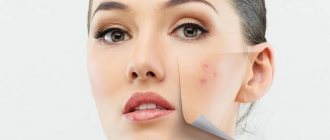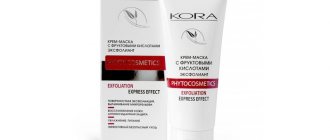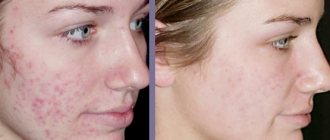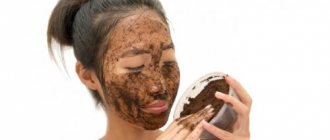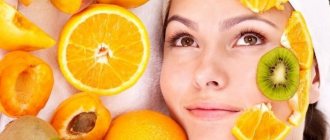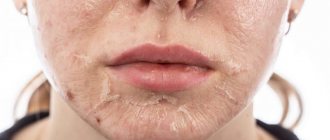The skin is an organ that reflects absolutely everything, age, health problems, negative environmental influences, stress and much more. Over time, it becomes dull, loses its attractiveness, pimples and blackheads may appear due to the fact that the pores become dirty. She requires special attention and care. You may even need mechanical or chemical facial cleansing. Modern cosmetology offers a huge selection of facial care methods that can be done at home without going to beauty salons.
Chemical cleaning techniques
The term “dry cleaning” sounds scary to many people, thinking that it is something bad for health. In fact, the concept of facial dry cleaning involves several procedures, varying in strength and mechanism of operation. They can be done at home.
There are two types of chemical cleaning:
- drug;
- enzymatic;
In the first case, various masks and preparations are used based on natural acids, such as fruit, lactic, salicylic, glycolic. In the second case, beneficial enzymes are used - bromelain and papain.
To start cleansing your face at home, you don’t have to wait until your skin and pores become very dirty. The earlier you start chemical facial cleansing, the more noticeable the effect will be. Cleansing is especially recommended for those who have an oily type and excessive sebum production. For dry skin, it is better to use a mask or peel with salicylic acid, and for those with problem or combination skin, mechanical treatment with glycolic acid is better.
Features of peeling in the salon
Chemical peeling is carried out in a course that requires preparation. You should start by consulting a doctor. Depending on the condition of the skin and the problems that need to be solved, he will make a cocktail of fruit acids and select the desired concentration. All this depends on skin type, its pH, health characteristics, etc.
The procedure is unlikely to be performed on the day of the consultation. The skin needs preparation.
“When preparing for peeling, it is better to use an integrated approach. It is recommended to adjust your usual skin care a month before the procedure.
- Include antioxidants in your usual beauty routine.
- Use a renewing (exfoliating) serum in the evenings (before applying night care products).
- Use sunscreens with the maximum level of protection (50). This is a prerequisite for preparing for a chemical peel.”
A chemical peel is a controlled chemical burn. The cosmetologist applies an acid or a mixture of acids to cleansed facial skin and leaves for several minutes. Then, with the help of a neutralizing substance, the reaction stops and the acids disintegrate. The first visual impression after peeling is not the most pleasant: redness, tightness, peeling. The skin needs rehabilitation and proper post-peeling care.
Skin care after chemical peeling
Post-peeling care
- the most delicate cleansing (give preference to soft foam cleansers);
- antioxidant serums to accelerate skin recovery;
- powerful moisturizing care (no oils!);
- products with an SPF factor of at least 50, intended for the face.
Acid peeling is a full-fledged medical procedure that requires attention and professional skills. The operation lasts no more than an hour, the acid exposure time is 10 minutes. The session is conducted in the following order:
- Cleansing the face of makeup;
- Degreasing;
- Apply the drug for 10 minutes;
- Neutralization of acid action;
- Using a soothing mask.
After the session, the doctor gives recommendations on how to care for your facial skin during its recovery and talks about safe cosmetics that promote rapid regeneration.
At the initial consultation, the specialist identifies contraindications, calculating the likely risks. The patient learns how to care for the skin correctly. In some cases, the following side effects are possible:
- The appearance of edema and swelling;
- Redness;
- Minor burns and microcracks.
With proper care, swelling and redness disappear a few days after the session. If symptoms persist, you should consult a doctor for advice.
The benefits of dry cleaning
Facial cleansing done at home is no different from a professional one, and helps to cleanse the face well, tighten pores, smooth out wrinkles and improve skin color. In addition, combined chemical and mechanical treatment of the face with various acids, ultrasound, peelings help normalize the activity of the sebaceous glands, tone and rejuvenate.
Chemical cleaning is more acceptable than any other hardware procedures because it has a gentle effect on the skin and does not injure the epithelium, but, on the contrary, soothes it.
Tips and reviews from cosmetologists
“Glycolic peeling (also known as hydroxyacetic acid peeling) differs in the concentration of acid, which can range from 5% to 70%.
- In the first case, the result will be only a slight renewal and smoothing of the skin surface, an improvement in complexion.
- In the second, the stratum corneum of the epidermis is “burned out” completely and the tissues are deeply renewed, which helps reduce visible age-related changes.”
Glycolic peeling in high concentration is carried out in the salon by a doctor. Already 3-4 procedures later there is a noticeable smoothing of the skin, and after a course of 10 peels the face looks much younger.
- a fairly long recovery period (in case of high concentrations) - up to a week;
- relatively long course;
- contraindications, as for any kind of traumatic procedures.
Leather preparation and cleaning processes
Before you begin the deep cleaning procedure at home, be sure to remove all makeup. The skin is cleansed of dirt, dust, excess fat using lotion or tonic. Now you can apply your chosen acid mixture. For the first layer, the concentration should be small so that the pores have time to open.
- As soon as the pores have steamed, you can proceed to the main stage: lubricate the skin of the face and problem areas with a concentrated solution of glycolic acid.
- The second layer is designed to remove blackheads from the pores, sebaceous fat from the glands, dissolving it, and removing dead skin cells of the epidermis. The mask lasts up to ten minutes, depending on sensitivity, and is washed off with warm water.
- Such deep cleaning greatly expands the pores, so it is necessary to make a mask to narrow and restore them.
If you want to remove more serious cosmetic skin defects or age spots at home, then you may need not chemical, but ultrasonic cleaning, which can have a stronger effect on the metabolism of skin tissue and its regeneration. Although with such a common problem as acne, it is better to use salicylic peeling. The solution has an antibacterial and anti-inflammatory effect, so it fights acne well. For problems such as pigmentation, a whitening chemical may be recommended.
Types of chemical peeling
The basis of the mechanism of action of the procedure is to stimulate the body to accelerate recovery after artificial damage - a burn, which occurs under the influence of special chemical compounds. Depending on the depth of the burn, the body’s reaction of varying degrees of intensity is formed.
Based on the depth of impact, the procedure is divided into three types:
- superficial - affects only the outer layer of the epidermis; in some cases, compositions are made that affect the entire epidermis;
- middle - reaches the upper layer of the dermis;
- deep - all layers of the skin are burned out.
After superficial peeling, active renewal of the stratum corneum of the epidermis begins, this is facilitated by:
- cleansing sebaceous ducts;
- restoration of the acid-base balance of the skin;
- reducing the number of pathogenic bacteria;
- elimination of excessive keratinization (hyperkeratosis);
- reduction in sebum production.
The simplest and safest procedure with no recovery period. There are no crusts or persistent redness on the skin. The result of peeling is smooth and silky skin. Elimination of minor pigment spots and lightening of the skin gives it a radiant and healthy appearance.
For the full effectiveness of surface peeling, a basic course of at least 4 sessions is recommended, which are performed once a week. It will be useful for teenagers with problem skin with acne, girls from 25 to 35 years old to get rid of imperfections and smooth out the skin, older ladies as preparation for deeper peeling.
Superficial peeling affects only the upper layers of the skin and cannot in any way contribute to rejuvenation; all the necessary structures for this process are located in the deeper layers. The visible anti-aging effect is the result of exfoliation, which makes the skin smoother and reflects light in a completely different way.
Medium peeling promotes:
- cell renewal - rejuvenation;
- activation of fibroblasts, increasing the synthesis of collagen and elastin to the level of young skin;
- suppression of the activity of melanocytes, which contribute to the appearance of age spots;
- strengthening blood vessels and improving blood circulation;
- thickening of the dermis and thinning of the epidermis.
After the procedure, numerous peeling crusts form on the skin, which disappear within 7–10 days. Moderate redness lasts up to 14 days. The recommended number of sessions is from 4 to 6. The result is a lasting cosmetic effect - smooth skin, clear contours and an even complexion. Firmness and elasticity increases, minor scars and stretch marks are smoothed out. In this case, you should buy Fermenkol gel.
READ ALSO: Retinol peeling at home: how to prepare and carry out the procedure correctly?
Medium peeling is practiced everywhere; many cosmetologists offer this procedure even at a young age. This is wrong - until the age of 35, the body itself produces sufficient amounts of collagen and elastin. A procedure used without recommended indications is absolutely useless and will only lead to disappointment, and in some cases can cause harm to health.
Medium chemical peeling with fruit acids: before and after photos
Deep facial peeling can be equated to a serious operation; it is performed under anesthesia in the presence of an anesthesiologist and is characterized by a recovery period of at least 6 months. The purpose of the procedure is:
- radical destruction and replacement of the skin framework;
- reconstruction of cellular composition;
- resumption of synthesis of hyaluronic acid, a natural skin moisturizer;
- restoration of elastin and collagen fibers.
Peeling is indicated to combat pronounced wrinkles, sagging and sagging skin, characteristic of age-related pigmentation. Recommended for ladies over 55 years old.
Active substances in chemical peeling
Fruit acids are also known by other names - AHA acids and alpha hydroxy acids. This group includes:
- dairy,
- lemon,
- apple,
- wine,
- glycolic acid.
The effect of active substances in this group contributes to:
- accelerating exfoliation of the stratum corneum of the epidermis;
- stimulation of natural skin hydration;
- thickening of the dermis;
- eliminating pathogenic bacteria;
- increasing the anti-inflammatory reaction of the skin;
- cleaning the ducts of the sebaceous glands.
Beta-hydroxy acids or BHA acids have all of the above properties and additionally improve the composition of the secretion of the sebaceous glands and suppress the activity of their work. Thanks to this, they are an excellent tool for the treatment and prevention of acne. The main active substance of this group is salicylic acid.
Natural skin cleansing products
For dry facial cleansing at home, you can use the following natural recipes:
- To make the keratinized layers of the skin softer, lubricate it with hydrogen peroxide.
- Steam your face over a hot decoction of chamomile or sage for five minutes.
- I exfoliate with salt and baking soda powder, preferably in a 1 to 1 ratio, after smearing the facial skin with soap or cream. So, a mechanical procedure is done. To tighten the pores, you can take a contrast shower - wash your face with warm and then cold water.
Apply a layer of hydrogen peroxide and let dry. Steam your face well, then rub it with a damp swab with this mixture:
- baking soda half a teaspoon;
- the same amount of borax;
- a teaspoon of coffee grounds;
- a pinch of thistle;
- We make several circular movements over all problem areas, then wash off with a decoction of herbs.
And one more way to do deep cleaning at home: first, wipe oily skin with salicylic alcohol. We soak a cotton pad in fine salt and cleanse the skin with massage movements. This procedure allows you to remove fat and blackheads.
Lactic Acid Cleaning
As you know, dairy products are not only cleaned, but also bleached. You can use kefir and milk as a mask. Its acid penetrates well into the subcutaneous layers, nourishing from the inside. Important tip: the oilier the skin, the more acidic the products used should be. It is best to apply the mixture and leave it on for 10–20 minutes. It will be good to leave the soaked skin in milk or curdled milk overnight, so it is recommended to do it at home. On the dry surface of the face, dairy products cause a slight burning sensation. Therefore, before the procedure, rinse the skin with plain water.
Cleaning with Calcium Chloride
Chemical facial cleansing using a calcium chloride solution is considered deep and more aggressive compared to other methods that can be done at home. However, you shouldn’t write it off. The effect will not be long in coming if you use the ingredients correctly.
- cleanse the skin well;
- moisten a cotton swab into the solution, lubricate the skin in three layers, leaving them to dry first;
- the soap foams, using soapy fingers, make circular movements over the entire area to be treated;
- dried calcium rolls behind your fingers, cleansing the skin;
- wash off the particles of the ray, apply a nourishing cream.
Main indications
The procedure is recommended to solve the following problems:
- high oily skin;
- enlarged pores;
- post-acne, scars and other defects;
- uneven skin color;
- wrinkles;
- age-related pigmentation.
If the above problems are not pronounced, dry cleaning is also performed for preventive purposes.
The procedure is contraindicated for people with pathologies of the cardiovascular system, cancer, diabetes, viral and skin diseases, inflammation, scratches and wounds. Pregnant and breastfeeding women, as well as people with intolerance to the substances used for peeling, sensitive and thin skin should not resort to cleaning (there is a risk of burns). You also need to be careful if you have moles on your face: they can be damaged by acid.
Fruit acids and their effects
Fruit acids contained in products such as lemon, tartaric acid, kefir, orange, apples are ideal for gentle peeling at home. It is better to crush the selected product into a paste, add a little crushed oatmeal to thicken the mass, and apply it to the face. Tingling and pinching indicate the action of acids on the pores. Doing such procedures at home is a pleasure, and quite inexpensive. Today we have access to fruits and ready-made products that are easy to buy at the pharmacy. Ultrasonic cleaning using a special device is possible.
What problems does peeling with fruit acids solve?
Peeling, exfoliation, exfoliation is getting rid of dead cells of the surface, stratum corneum of the skin. Why remove it? To ensure that the skin is renewed and does not look dull. Along the way, peeling with fruit acids can solve a lot of problems. Let's talk about everything in order.
Fruit acids weaken the bonds between the cells of the stratum corneum and thus promote their removal, revealing clean, young skin.
- The skin, devoid of the “husk” of dead cells, looks fresh and radiant.
- As a result of controlled trauma to the skin, the process of its renewal begins. The basic principle of action of fruit (and any other) peeling is based on stimulating the self-healing of cells - they produce collagen and elastin more intensively, rushing to “fix” everything.
- For the same reason, young cells more actively produce natural moisturizing factor, which contributes to the healthy functioning of the skin.
“Any peeling is perceived by the skin as trauma. And since there has been an injury and the skin is damaged, it is urgent to synthesize scaffold fibers and glycosaminoglycans of the dermis to restore the defect. This way, not only the surface layer of the epidermis is renewed, but also the deep layers of the dermis.”
Peeling with fruit acids is said to be the most gentle. But if you have thin, dry or sensitive skin, it is best to consult your doctor before undergoing the procedure.
When to use
Fruit peeling has become a familiar skin care routine for many. Home exfoliation courses and significantly more effective peeling courses in a salon or clinic act against:
- photoaging and wrinkles;
- pigmentation;
- post-acne, scars and scars (not too deep);
- acne - beta hydroxy acids, such as salicylic acid, are used to combat this problem (but your doctor may also recommend fruit peeling).
- dullness of the skin with hyperkeratosis (too thick stratum corneum of the skin).
“The older we get, the more important tissue renewal is: with age, the natural cycle of differentiation and maturation of keratinocytes lengthens and instead of a month it is 50–60 days. It is necessary to exfoliate your skin, otherwise aging will only accelerate. The regeneration processes will slow down significantly, and the penetration of anti-aging treatments will be difficult.”
Efficiency
The effectiveness of fruit peeling is related to the acid concentration. After a very superficial home peel, the pigment spot will become paler. And after a course of superficial peeling in the salon (with a higher concentration of acids), it may disappear completely.
Peels with fruit acids have become popular because the rehabilitation process after the procedure is usually not very long, and the effect - renewed and radiant skin - is noticeable almost immediately.
Fruit acids are also called alpha hydroxy acids (AHAs), they are quite gentle on the skin. To get a visual representation of the main sources of AHAs, you can arrange the fruit nicely on a large platter. Each fruit and berry has its own cosmetic ingredient, or even a whole complex.
Fruit acids
Let's list the most popular fruit acids for peelings.
- Glycolic (from sugar cane) is perhaps the most popular AHA acid. It is used in a huge range of concentrations, from 2% in home toners to 70% in salon products.
- Almond (from sweet almonds) is the softest (along with lactic acid).
- Lactic acid, of course, is not fruit in origin, since it is obtained as a result of milk fermentation, but in terms of characteristics and action it still belongs to this category. It is considered the softest of the AHA acids, suitable for use even on damaged, sensitive skin.
- Pyruvic acid (wine) - found in grapes. Pyruvic peeling at a certain acid concentration can have a deeper effect than the most popular glycolic peel.
- Apple juice is made not only from apples, but also from many other fruits and berries: apricots, cherries, cherries. It also has pronounced antioxidant properties.
- Lemon is popular in whitening peels because, in addition to exfoliating, it also has whitening properties. Not only and not so much citrus fruits are rich in it, but, for example, blueberries.
- Phytic acid acts quite gently. It is obtained from cereal extracts, such as rice husk, quinoa, etc. Gently exfoliates and has an antioxidant effect.
Which cleaning to choose
Before choosing any chemical facial treatment method at home, you should consult a dermatologist and find out your skin type. It is best to use manual cleaning. They are more effective for oily and mixed skin types. For normal and non-problematic skin, an ultrasound procedure is suitable, in a beauty salon or with a special device, at home.
After dry cleansing, the face may be slightly red and tender. In this case, you need to avoid direct sunlight, strong wind and rain. It is also not recommended to use decorative cosmetics. But, no matter how threatening the name of the technique may sound, mechanical cleaning with various acids is much better than ultrasonic cleaning. And it gives much better results.
What is the difference?
In order to determine the differences between the two cosmetic procedures, let’s consider the essence of each process:
- Peeling is a session of deep cleansing of the epidermis, during which the upper dead layer of cells is removed. After its removal, the mechanism of enhanced natural restoration of the skin is launched.
- Cleansing is a hygienic procedure during which the skin is cleansed of acne, sebaceous plugs and blackheads. After cleansing, the epidermis begins intensive renewal.
Distinctive features of peeling:
- Experts recommend peeling if the skin has wrinkles, age spots, has lost its elasticity and has become dull.
- Can be used on any skin type.
- The procedure is prescribed for persons over 25 years of age.
Distinctive features of cleaning:
- Relevant for people with sebaceous plugs, blackheads and comedones on the face.
- First of all, it is recommended for those with oily and problematic skin.
- The procedure can be carried out from adolescence, when skin problems appear against the background of hormonal changes in the body.
There are several types of professional facial cleansing that can be performed by a cosmetologist:
- Mechanical. The easiest way to cleanse. It involves manually removing unwanted elements from the skin. The cosmetologist can carry out the procedure with his hands or use special cosmetology tools: a Uno spoon, a brush, a Vidal needle, a loop. During the session, damage to the skin is possible.
- Vacuum. For cleaning, a special vacuum device is used, which operates on the principle of a vacuum cleaner.
Before the procedure, the face must be steamed.The device pulls out dirt and sebaceous plugs from the pores, and also removes dead cells.
- Ultrasonic. It is carried out using a special device - a scrubber. The opening of pores, their cleaning and removal of the upper layer of the epidermis occurs under the influence of ultrasound. Ultrasonic cleaning is painless and takes little time.
- Galvanic. Purification occurs under the influence of electric current from a galvanic device. Under its influence, the pores expand and their contents are destroyed. Before the procedure, a special gel is applied to the face, which conducts current and ensures better glide of the device, and also interacts with the contents of the pores. The procedure is painless and does not damage the skin.
Vacuum, ultrasonic and galvanic cleaning are hardware cleaning methods. During hardware procedures, only the upper layer of the epidermis is affected.
